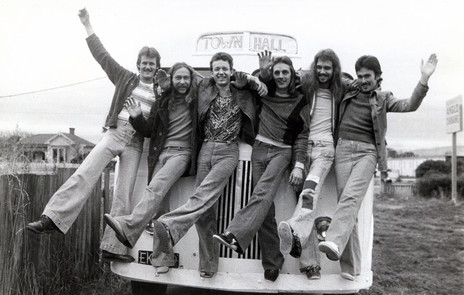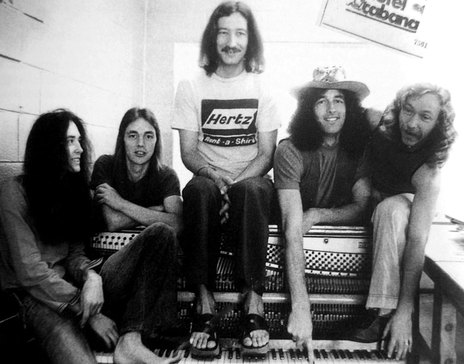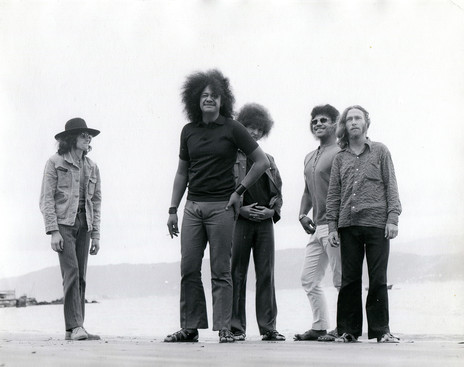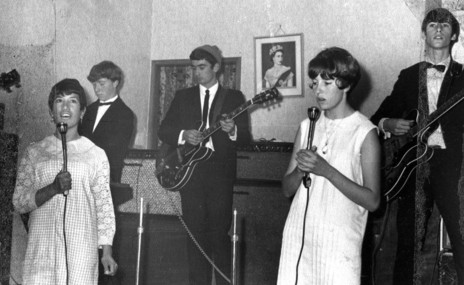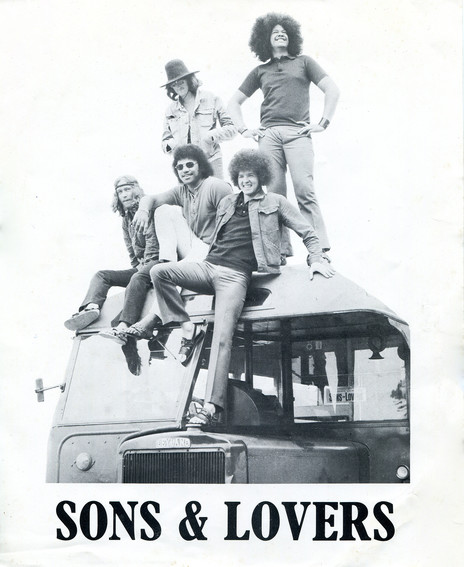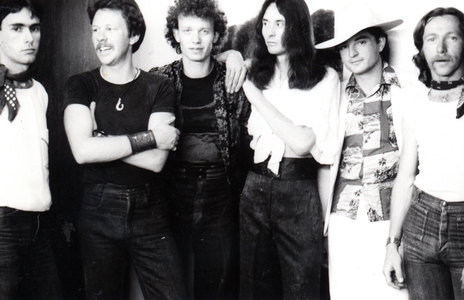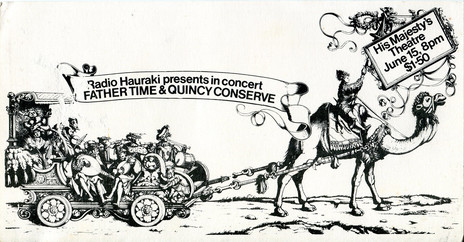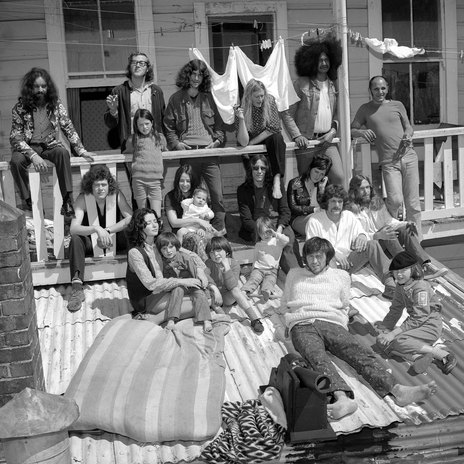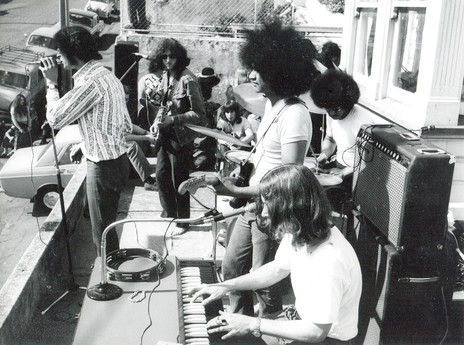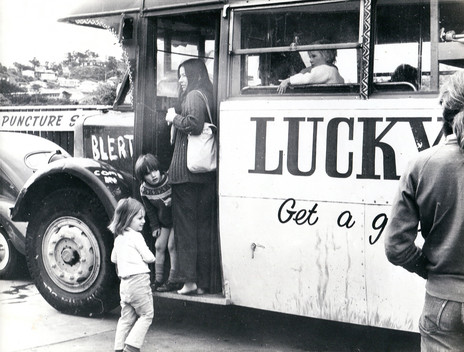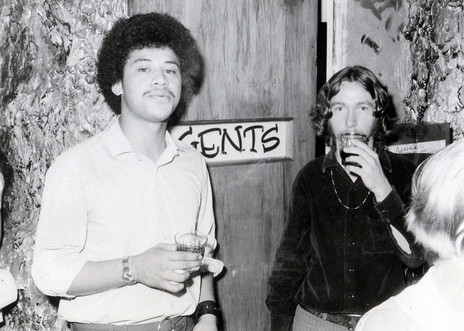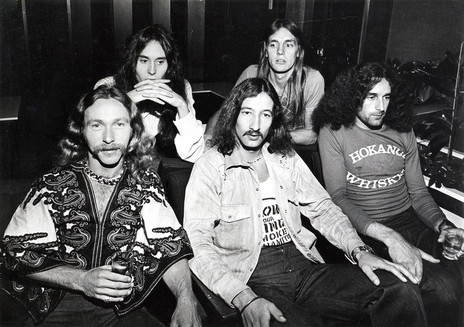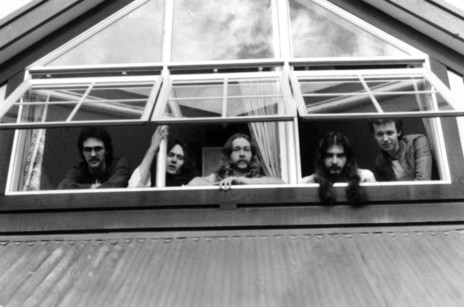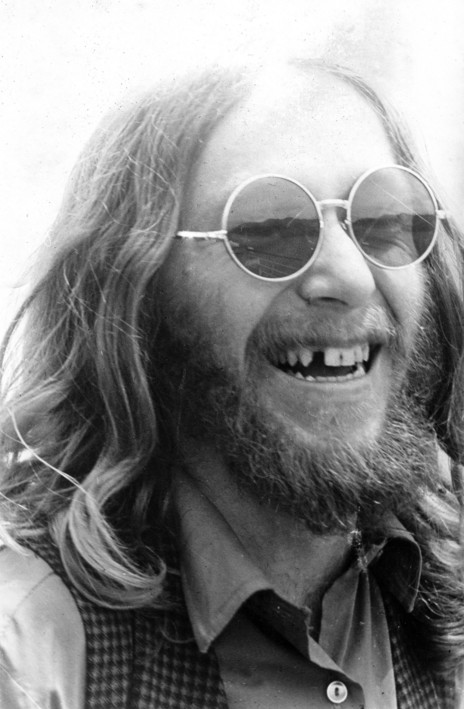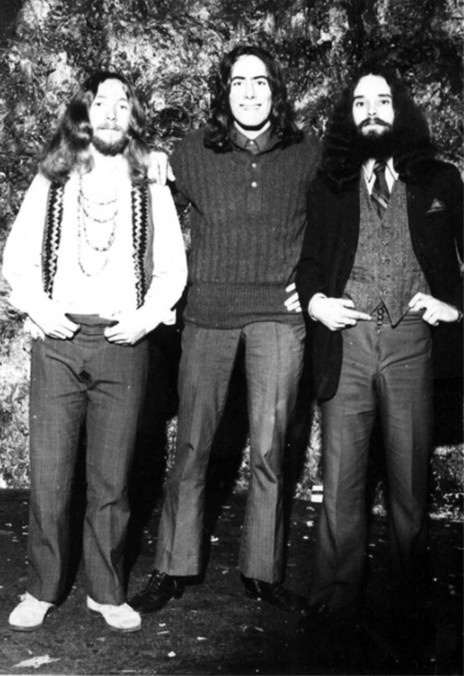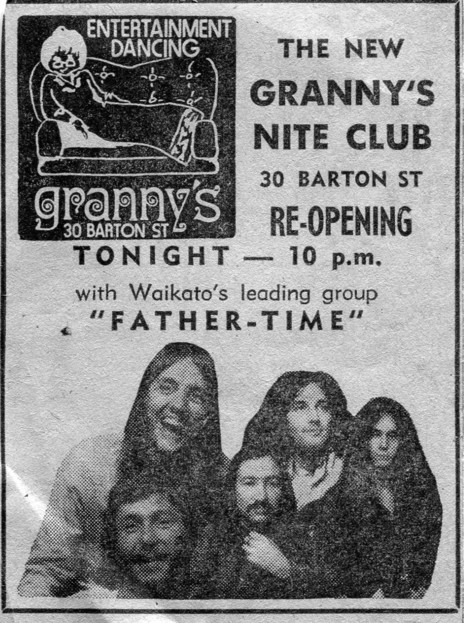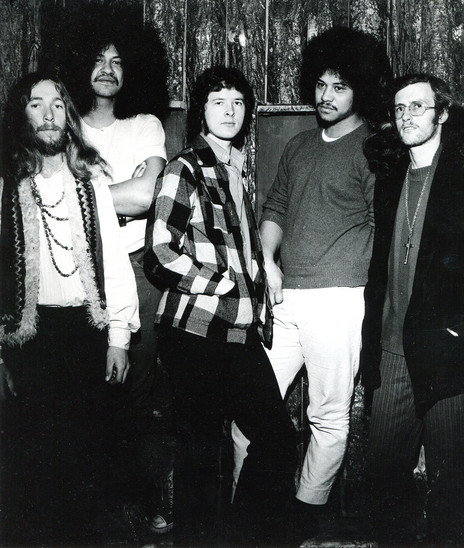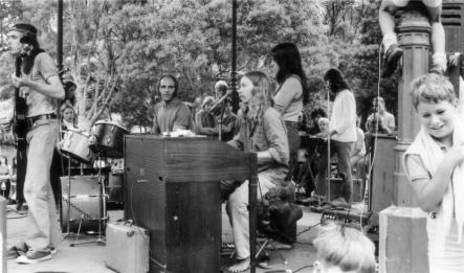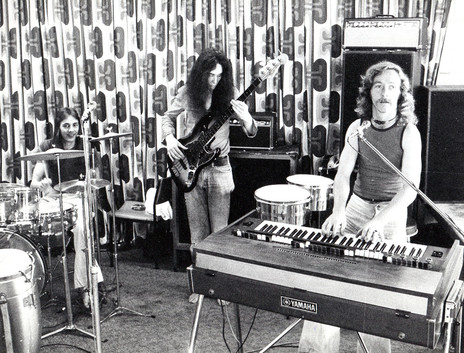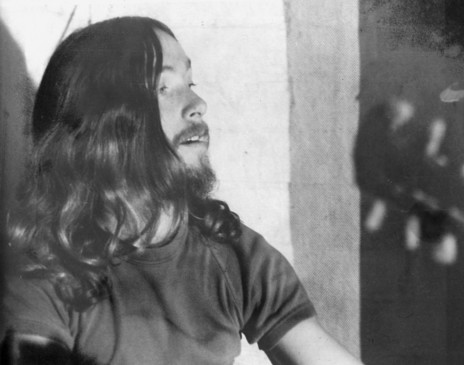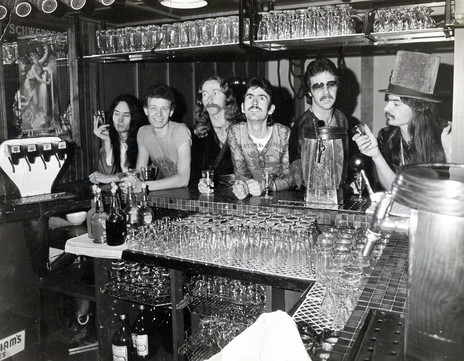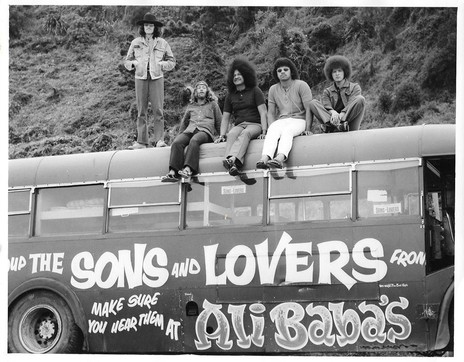Alan Moon, or “Moonie” to his friends, was a professional musician most of his life, complementing that with driving courier and delivery trucks. “His favourite was driving for Tip Top. He loved his ice cream,” says his younger sister, Myra Moon.
Alan was the third of seven children. In 1960 the Moon family moved to Otakiri, a rural community outside Whakatane where their parents ran the local Four Square.
“Our uncle on Dad’s side was musically gifted and was selected for the Vienna Boys Choir, but my nana didn’t want him to go, so he never pursued his singing. There’s talent in the genes but Alan seemed to be the only one suitably blessed in the arts,” says Myra.
He was self-confident, active in the drama and film clubs at college, and won his sixth-form speech contest at Edgecumbe College with a piece titled “Nothing”. A BLERTA gig some years later at his old school was his chance to give a little “something” back.
His first opportunity to play in a band came while still in the sixth form when he joined the second version of popular Whakatane rock’n’roll unit The Nomads.
He and Paul Curtis were on vocals, with Red Miller on guitar and Lyn “Scratch” Rhea on bass. They linked up with original members Jackie Howat on lead guitar and Peter McArthur on drums. They played dances, ran their own gigs and backed other artists when they came to town, including Bill & Boyd, The Chicks and Tommy Adderley.
in 1968 alan judd took the best musicians from various guest bands, creating Sons & Lovers.
In 1965 Alan and Sue Judd owned the Aztec nightclub in Tauranga, which had a DJ and dancefloor with live entertainment two to three times a week. At one point the club even broadcast to the region as Radio Active. That was well before student radio at Victoria University of Wellington took the name, and concurrent to Hauraki’s offshore broadcasts.
Judd says he “hatched a plan” in 1968 and took the best musicians from various guest bands, creating Sons & Lovers. The band initially featured Ali Matthews on drums and vocals, Steve Marriner on bass and vocals, Corben Simpson on lead guitar and vocals and Alan Moon from the Nomads on keys, percussion and arrangements. Judd cast himself as equal partner in the enterprise.
With Simpson moving to the front, the band was playing harder-edged British pop and rock material, and they came first equal in the Waikato heat of Battle of the Bands.
Corben’s solo career was gaining traction and a new love interest saw him quit Sons & Lovers to be closer to his girlfriend in Hamilton. Sons & Lovers added Ron Liley on lead guitar, later replaced by Lyn Rhea.
The band was in strong demand in Auckland and Hamilton and eventually moved from Tauranga to Wellington in 1971, where they went through a further line-up change to secure a two-year residency at Ali Baba’s nightclub.
In this fourth line-up another refugee from Tauranga’s Nomads, Paul Curtis, joined on lead vocals, acoustic guitar and harmonica. Dave Clark was added on lead guitar and later replaced by Robbie Mackie and then Kemp Tuirirangi with Rhea stepping back to his favoured instrument, bass. A further line-up change saw Curtis (later with Farmyard) replaced by Peter Leef (the younger brother of Simple Image singer Barry Leef) on lead vocals.
Alan Moon was musical director, focusing on everything from vocal harmonies, soulful ballads and pop to progressive rock, says Judd. “He was our equivalent to Quincy Jones, a natural producer, arranger and ahead of the times. We all voted on the repertoire, even me at times. Even though it got quite fraught at times, Alan’s charm, wit and musical feel smoothed things over. From rehearsal to the stage his professionalism produced some really epic performances.”
The band was playing whatever was popular on the charts at the time. Peter Leef says Sons & Lovers had to sound as much like the original as possible. He recalls Alan as “an absolute professional and a perfectionist”. Outside the band, which Leef was in for about 15 months, he says Moonie was “a fun guy”.
Judd purchased a 1948 Leyland Tiger bus for $250 at a Wellington City Council auction. “That was quite a large sum for those times,” he says. “We fitted it with bunks and seats, which cost more than the bus did.”
Sons & Lovers were preparing to play a gig several hundred kilometres north and decided to load the gear aboard to prepare for the journey ahead. “Everything went well until we went to load the large and heavy Hammond organ we had purchased from Lewis Eadys in Auckland.”
Judd and Moonie were dismayed. There was no way it was going to fit through any door on the bus. “It was a catastrophe. The only solution I could see was to get a bigger door made for loading gear onto the bus.”
Judd rushed around getting quotes for the work but no one could do it in time to get to the gig and the cost was a real concern. Then he caught a lucky break while driving through Greytown. “I spotted a company specialising in panel work on buses. Unbelievably, they said they could do it in the time frame but the cost was beyond our means.”
Moon quizzed him: “How on earth are we going to pay for that? We are skint.” Judd assured him all would be right, the money would be found somehow.
The term “lucky break” kept whirring through Judd’s head and then he had another brainwave as he spotted a large advertisement for Lucky Strike cigarettes.
they had to paint a huge “Lucky Strike” cigarette advert on one side of the bus.
He went to their offices, “met a switched on music fan in their advertising department”, and within an hour they had agreed to pay twice as much as the whole project was going to cost for the bus, bunks, seats and door.
In return they had to paint a huge “Lucky Strike” cigarette advertisement on one side of the bus, and Sons & Lovers on the other. The new door was completed along with the paint job and the bus was collected on the Friday morning, with Judd driving it back to Wellington. “Alan initially didn’t believe it was paid for until I walked him around the other side and the lights went on. ‘You are a lucky bugger,’ he said, ‘I will never doubt you again.’”
Myra Moon says the big old red bus “was a bit cantankerous and Alan was the only one who knew how to handle it”.
All members of Sons & Lovers were flatting at 33 Austin St, Wellington, including Glenn Timihou, who played with Kemp Tuirirangi in other units.
Meanwhile back in Hamilton, Corben Simpson had joined the Movement with Don Bedgegood on guitar and Larry Abbott on drums (both formerly in Dragon forerunner Anteapot), and bass player Tony Littlejohn. They also headed to Wellington, where they soon had bookings and a recording deal with Sonic Studios.
However, before their first single was released, they ran into legal difficulties and a quick decision was made to change their name to Littlejohn.
Just as things were looking up, including an opportunity to back Simpson on his first solo album, Bedgegood and Abbott headed back to Waikato.
New musicians were urgently needed to complete the string of bookings and studio work. Edd Morris – owner of the Strange record label – arranged for session drummer Bruno Lawrence to join Simpson and Littlejohn for the live gigs at Lucifer’s nightclub starting in September 1971.
A month later Simpson’s old band Sons & Lovers was folding, which opened the way for Kemp Tuirirangi and Alan Moon to complete the Littlejohn line-up. Part of that transaction saw the unit acquire the temperamental old Sons & Lovers bus.
Moon joined Littlejohn and Lawrence for Corben Simpson’s debut solo album.
The new and expanded line-up was quickly in the studio completing the Littlejohn album, an eclectic mix of hard rock and ballads that included Simpson’s single, ‘Have You Heard A Man Cry’.
Moon also joined Littlejohn and Lawrence for Corben Simpson’s debut solo album, playing Hammond organ, with Mike Le Petit on piano and Desna Sisarich on backing vocals.
Most of Simpson’s singles on the Strange label, along with the Littlejohn LP on Polydor, were released in 1971 and early 1972, but by then the musicians were heading in much more colourful direction.
Bruno Lawrence had been working with trumpet player Geoff Murphy and a group of jazz musicians along with his Acme Sausage Company film and lighting crew. They were soon joined by actors, costume makers and arty, hippie types who wanted to be part of the great touring theatrical experiment.
Jazz players from the Wellington Musicians Club, including teenage singer Beverley Morrison (aka Beaver) were soon roped into the vision that became BLERTA (Bruno Lawrence’s Electric Revelation and Travelling Apparition).
Out of the kids shows, created to ease the tension when the anarchy that was BLERTA came to town, arose the now famous adaptation of a Margaret Mahy story that morphed into ‘Dance All Around the World’.
Alan Moon remained with the BLERTA troupe for their early recording sessions then headed off to Melbourne. The exit wasn’t unexpected. Enthusiasm and passion only lasts so long while you’re struggling to pay the bills or even find petrol money to keep the show on the road.
On his return to Hamilton in 1974, “Moonie” was recruited to join Father Time, a new progressive rock unit put together by vocalist Steve Grant and guitarist Phil Whitehead, who had been in a revitalised and highly popular pub circuit band Movement. They had joined with Lindsay Brook on drums and Don Martin on bass, who had both been with another long serving circuit band, Freeway.
Don Bedgegood, another former Movement member (from the Simpson/Littlejohn version), had picked up the slack when Whitehead was whisked away to join a reformed Human instinct after only three months.
Father Time, joined by Alan Moon – now master of the latest Yamaha keyboard and synthesiser – scored a three-month residency at Napier’s Cabana. They were in demand around the country, and based in Auckland, where they lived in an old villa in Crummer Rd, Grey Lynn.
With their impeccable musical pedigree turning to a fatter, more symphonic rock and steering well clear of the old glam rock repertoire of their previous bands, they were a crowd pleaser.
Father Time disbanded in May 1977. Moon, Grant and Martin added Think founding member and guitarist Kevin Stanton and Phil Smart on drums to become Fragments of Time.
Steve Gilpin, a frustrated rock’n’roller better known as a cabaret singer, had caught their act at the Awapuni Hotel in Palmerston North and joined them as they explored how to evolve their sound.
Fragments of Time was the end of the line for Alan Moon’s involvement in the New Zealand music scene. Alan’s sister Myra suggests the style of music the band were moving into didn’t suit his aspirations. He quit the band in 1978 and was replaced by Murray Burns on keyboards. A series of drummers eventually saw Richard Hodgkinson on drums and the group transformed their look. With short haircuts, tank tops and leather pants, they led New Zealand into the new wave era and ultimately international recognition as Mi-Sex.
Fragments of Time was the end of the line for Alan Moon’s involvement in the New Zealand music scene.
At the time Mi-Sex were starting to make an impact across the Tasman, symphonic rockers Think were doing well on the Melbourne circuit, having released their album We’ll Give You A Buzz in 1976.
Former Father Time drummer and singer Lindsay Brook had taken over the vocalist role in Think from Ritchie Pickett. Band leader and guitarist Phil Whitehead and fellow players, including bassist Allan Badger, were frustrated with Melbourne-based Mushroom Records. They were still waiting for the promised album promotion and new recording sessions. Don Mills (keyboards) and then Neville Jess (drums) were sick of waiting and lured back home for a gig in Christchurch.
Still hopeful of a future with Mushroom, Lindsay Brook persuaded Alan Moon to fly over and join them. English drummer Robbie France-Shaw completed the line-up. While recordings were made, they were never released. After just a few more gigs Think folded.
Moon remained in Melbourne, taking on low key jobs, including playing piano for fashion parades at Myer department store. He also worked for a funeral director until he became too ill to work.
Moon had boarded with Sue and Alan Judd in Tauranga when he first joined Sons & Lovers and after his time with BLERTA. On his return from Australia, he appeared at the Judds’ door again with the news he had contracted HIV.
“We regularly spent time together until he was confined to his bed in the Rotorua Hospital where we visited him. He fought courageously against the odds, believing he might be cured. Right to the end he still managed to laugh about the great times we had.”
Myra Moon says music was pretty much Alan’s obsession and while he was a joker – a prankster who used to enjoy keeping things light or playing tricks on his band mates and living life to the full – he also had a serious side which he often kept to himself.
“He was certainly an interesting brother,” says Myra, four years his junior.
Alan Moon was the 15th New Zealander to die of HIV/AIDS. On learning of his condition his parents brought him home to Rotorua in 1987; from Christmas that year he went rapidly downhill, with Alzheimer’s disease complicating his condition.
In those early days of the infection, Myra says, the medical profession was ill equipped to cope with his condition. “There was little information about how to treat the disease, a lot of bias and little support for family.”
Alan Michael Moon died in November 1988 at the age of 38. He was held in high regard by all those he played with across his years in the music industry. Bruno and Veronica Lawrence were among those who sat with him at his deathbed. Myra says Bruno held his hand and kept saying, “Magic fingers.”
